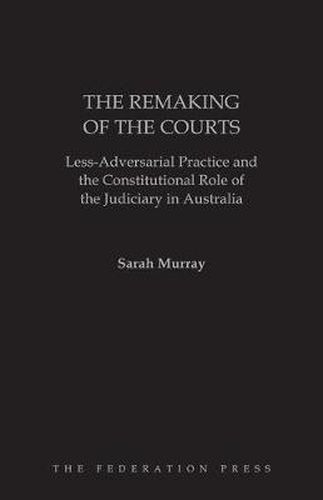Readings Newsletter
Become a Readings Member to make your shopping experience even easier.
Sign in or sign up for free!
You’re not far away from qualifying for FREE standard shipping within Australia
You’ve qualified for FREE standard shipping within Australia
The cart is loading…






The Remaking of the Courts: Less-Adversarial Practice and the Constitutional Role of the Judiciary in Australia centres on the changing nature of courts within the Australian constitutional context. In essence, the monograph explores the degree to which less-adversarial innovations and the remodelling of the judicial role can be accommodated within Australia’s constitutional framework. The work draws upon comparative principles, separation of powers, jurisprudence and the theoretical perspectives of constitutionalism and neo-institutionalism. By examining Chapter III of the Commonwealth Constitution, and applying Chapter III approaches to less-adversarial case-studies traversing state and federal fields, the book argues that less-adversarial judicial practices can be broadly accommodated by the Australian constitutional framework. However, the book asserts that the clarity and suitability of the Chapter III constitutional approaches employed would be significantly improved by the adoption of a ‘contextual incompatibility’ methodology which would protect the constitutional role of the courts while not forestalling constitutionally compatible reform.
$9.00 standard shipping within Australia
FREE standard shipping within Australia for orders over $100.00
Express & International shipping calculated at checkout
The Remaking of the Courts: Less-Adversarial Practice and the Constitutional Role of the Judiciary in Australia centres on the changing nature of courts within the Australian constitutional context. In essence, the monograph explores the degree to which less-adversarial innovations and the remodelling of the judicial role can be accommodated within Australia’s constitutional framework. The work draws upon comparative principles, separation of powers, jurisprudence and the theoretical perspectives of constitutionalism and neo-institutionalism. By examining Chapter III of the Commonwealth Constitution, and applying Chapter III approaches to less-adversarial case-studies traversing state and federal fields, the book argues that less-adversarial judicial practices can be broadly accommodated by the Australian constitutional framework. However, the book asserts that the clarity and suitability of the Chapter III constitutional approaches employed would be significantly improved by the adoption of a ‘contextual incompatibility’ methodology which would protect the constitutional role of the courts while not forestalling constitutionally compatible reform.